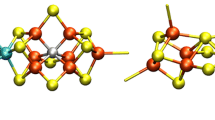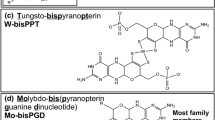Abstract
Abstract
The molybdopterin enzyme family catalyzes a variety of substrates and plays a critical role in the cycling of carbon, nitrogen, arsenic, and selenium. The dimethyl sulfoxide reductase (DMSOR) subfamily is the most diverse family of molybdopterin enzymes and the members of this family catalyze a myriad of reactions that are important in microbial life processes. Enzymes in the DMSOR family can transform multiple substrates; however, quantitative information about the substrate preference is sparse, and, more importantly, the reasons for the substrate selectivity are not clear. Molybdenum coordination has long been proposed to impact the catalytic activity of the enzyme. Specifically, the molybdenum-coordinating residue may tune substrate preference. As such, molybdopterin enzyme periplasmic nitrate reductase (Nap) is utilized as a vehicle to understand the substrate preference and delineate the kinetic underpinning of the differences imposed by exchanging the molybdenum ligands. To this end, NapA from Campylobacter jejuni has been heterologously overexpressed, and a series of variants, where the molybdenum coordinating cysteine has been replaced with another amino acid, has been produced. The kinetic properties of these variants are discussed and compared with those of the native enzyme, providing quantitative information to understand the function of the molybdenum-coordinating residue.
Graphic abstract













Similar content being viewed by others
Data availability
The authors have included all data sets in the manuscript or in the supporting information. Additional details may be provided upon request to the corresponding author.
References
Schoepp-Cothenet B, van Lis R, Philippot P, Magalon A, Russell MJ, Nitschke W (2012) The ineluctable requirement for the trans-iron elements molybdenum and/or tungsten in the origin of life. Sci Rep 2:263–263
Weiss MC, Sousa FL, Mrnjavac N, Neukirchen S, Roettger M, Nelson-Sathi S, Martin WF (2016) The physiology and habitat of the last universal common ancestor. Nat Microbiol 1:16116
Wells M, Kanmanii NJ, Al Zadjali AM, Janecka JE, Basu P, Oremland RS, Stolz JF (2020) Methane, arsenic, selenium and the origins of the DMSO reductase family. Sci Rep 10:10946
Boyington JC, Gladyshev VN, Khangulov SV, Stadtman TC, Sun PD (1997) Crystal structure of formate dehydrogenase H: catalysis involving Mo, molybdopterin, selenocysteine, and an Fe4S4 cluster. Science 275:1305–1308
Mintmier B, Nassif S, Stolz JF, Basu P (2020) Functional mononuclear molybdenum enzymes: challenges and triumphs in molecular cloning, expression, and isolation. J Biol Inorg Chem 25:547–569
Hettmann T, Siddiqui RA, Frey C, Santos-Silva T, Romao MJ, Diekmann S (2004) Mutagenesis study on amino acids around the molybdenum center of the periplasmic nitrate reductase from Ralstonia eutropha. Biochem Biophys Res Commun 320:1211–1219
Garde J, Kinghorn JR, Tomsett AB (1995) Site-directed mutagenesis of nitrate reductase from Aspergillus nidulans. Identification of some essential and some nonessential amino acids among conserved residues. J Biol Chem 270:6644–6650
Axley MJ, Boeck A, Stadtman TC (1991) Catalytic properties of an Escherichia coli formate dehydrogenase mutant in which sulfur replaces selenium. Proc Natl Acad Sci U S A 88:8450–8454
Pollock VV, Barber MJ (2000) Serine 121 is an essential amino acid for biotin sulfoxide reductase functionality. J Biol Chem 275:35086–35090
Schrapers P, Hartmann T, Kositzki R, Dau H, Reschke S, Schulzke C, Leimkuehler S, Haumann M (2015) Sulfido and cysteine ligation changes at the molybdenum cofactor during substrate conversion by formate dehydrogenase (FDH) from Rhodobacter capsulatus. Inorg Chem 54:3260–3271
Kaufmann P, Duffus BR, Mitrova B, Iobbi-Nivol C, Teutloff C, Nimtz M, Jansch L, Wollenberger U, Leimkuhler S (2018) Modulating the Molybdenum coordination sphere of Escherichia coli trimethylamine N-Oxide reductase. Biochemistry 57:1130–1143
Trieber CA, Rothery RA, Weiner JH (1996) Consequences of removal of a molybdenum ligand (DmsA-Ser-176) of Escherichia coli dimethyl sulfoxide reductase. J Biol Chem 271:27339–27345
Hilton JC, Temple CA, Rajagopalan KV (1999) Re-design of Rhodobacter sphaeroides dimethyl sulfoxide reductase. Enhancement of adenosine N1-oxide reductase activity. J Biol Chem 274:8428–8436
Garrett RM, Rajagopalan KV (1996) Site-directed mutagenesis of recombinant sulfite oxidase. Identification of cysteine 207 as a ligand of molybdenum. J Biol Chem 271:7387–7391
Qiu JA, Wilson HL, Pushie MJ, Kisker C, George GN, Rajagopalan KV (2010) The structures of the C185S and C185A mutants of sulfite oxidase reveal rearrangement of the active site. Biochemistry 49:3989–4000
Reschke S, Niks D, Wilson H, Sigfridsson KGV, Haumann M, Rajagopalan KV, Hille R, Leimkuhler S (2013) Effect of exchange of the cysteine molybdenum ligand with selenocysteine on the structure and function of the active site in human sulfite oxidase. Biochemistry 52:8295–8303
Gates AJ, Richardson DJ, Butt JN (2008) Voltammetric characterization of the aerobic energy-dissipating nitrate reductase of Paracoccus pantotrophus: exploring the activity of a redox-balancing enzyme as a function of electrochemical potential. Biochem J 409:159–168
Sabaty M, Avazeri C, Pignol D, Vermeglio A (2001) Characterization of the reduction of selenate and tellurite by nitrate reductases. Appl Environ Microbiol 67:5122–5126
Johnson KE, Rajagopalan KV (2001) An active site tyrosine influences the ability of the dimethyl sulfoxide reductase family of molybdopterin enzymes to reduce S-oxides. J Biol Chem 276:13178–13185
Morpeth FF, Boxer DH (1985) Kinetic analysis of respiratory nitrate reductase from Escherichia coli K12. Biochemistry 24:40–46
Mintmier B, McGarry JM, Sparacino-Watkins CE, Sallmen J, Fischer-Schrader K, Magalon A, McCormick JR, Stolz JF, Schwarz G, Bain DJ, Basu P (2018) Molecular cloning, expression and biochemical characterization of periplasmic nitrate reductase from Campylobacter jejuni. FEMS Microbiol Lett 365:fny151
Fersht A (1999) Structure and mechanism in protein science: a guide to enzyme catalysis and protein folding, W. H. Freeman Company
Dixon M (1953) The effect of pH on the affinities of enzymes for substrates and inhibitors. Biochem J 55:161–170
Tipton KF, Dixon HBF (1979) Effects of pH on enzymes. Methods Enzymol 63:183–234
Ellis PJ, Conrads T, Hille R, Kuhn P (2001) Crystal structure of the 100 kDa arsenite oxidase from Alcaligenes faecalis in two crystal forms at 1.64 Å and 2.03 Å. Structure 9:125–132
Warelow TP, Oke M, Schoepp-Cothenet B, Dahl JU, Bruselat N, Sivalingam GN, Leimkuehler S, Thalassinos K, Kappler U, Naismith JH, Santini JM (2013) The respiratory arsenite oxidase: structure and the role of residues surrounding the Rieske cluster. PLoS ONE 8:e72535
Bursakov S, Liu M-Y, Payne WJ, LeGall J, Moura I, Moura JJG (1995) Isolation and preliminary characterization of a soluble nitrate reductase from the sulfate reducing organism Desulfovibrio desulfuricans ATCC 27774. Anaerobe 1:55–60
O’Fagain C, Butler BM, Mantle TJ (1983) The effect of pH on the kinetics of arylsulfatases A and B. Biochem J 213:603–607
Brody MS, Hille R (1999) The kinetic behavior of chicken liver sulfite oxidase. Biochemistry 38:6668–6677
Cheng VWT, Weiner JH (2014) S- and N-oxide reductases. EcoSal Plus, 1–32
Ridge JP, Aguey-Zinsou K-F, Bernhardt PV, Brereton IM, Hanson GR, McEwan AG (2002) Site-directed mutagenesis of dimethyl sulfoxide reductase from Rhodobacter capsulatus: Characterization of a Y114 → F mutant. Biochemistry 41:15762–15769
Krissinel E, Henrick K (2004) Secondary-structure matching (SSM), a new tool for fast protein structure alignment in three dimensions. Acta Crystallogr. Sect D: Biol Crystallogr D60:2256–2268
Fourmond V, Sabaty M, Arnoux P, Bertrand P, Pignol D, Leger C (2010) Reassessing the strategies for trapping catalytic intermediates during nitrate reductase turnover. J Phys Chem B 114:3341–3347
Fourmond V, Burlat B, Dementin S, Sabaty M, Arnoux P, Etienne E, Guigliarelli B, Bertrand P, Pignol D, Leger C (2010) Dependence of catalytic activity on driving force in solution assays and protein film voltammetry: insights from the comparison of nitrate reductase mutants. Biochemistry 49:2424–2432
Sadana JC, McElroy WD (1957) Nitrate reductase from Achromobacter fischeri. Purification and properties: flavines and cytochrome. Arch Biochem Biophys 67:16–34
Berks BC, Richardson DJ, Robinson C, Reilly A, Aplin RT, Ferguson SJ (1994) Purification and characterization of the periplasmic nitrate reductase from Thiosphaera pantotropha. Eur J Biochem 220:117–124
Bursakov SA, Carneiro C, Almendra MJ, Duarte RO, Caldeira J, Moura I, Moura JJG (1997) Enzymic properties and effect of ionic strength on periplasmic nitrate reductase (NAP) from Desulfovibrio desulfuricans ATCC 27774. Biochem Biophys Res Commun 239:816–822
Zeamari K, Gerbaud G, Grosse S, Fourmond V, Chaspoul F, Biaso F, Arnoux P, Sabaty M, Pignol D, Guigliarelli B, Burlat B (2019) Tuning the redox properties of a [4Fe-4S] center to modulate the activity of Mo-bisPGD periplasmic nitrate reductase. Biochim Biophys Acta Bioenerg 1860:402–413
Callister SJ, Nicora CD, Zeng X, Roh JH, Dominguez MA, Tavano CL, Monroe ME, Kaplan S, Donohue TJ, Smith RD, Lipton MS (2006) Comparison of aerobic and photosynthetic Rhodobacter sphaeroides 2.4.1 proteomes. J Microbiol Methods 67:424–436
John N, Vidyalakshmi VB, Hatha AAM (2019) Effect of pH and salinity on the production of extracellular virulence factors by Aeromonas from food sources. J Food Sci 84:2250–2255
Do H, Makthal N, VanderWal AR, Saavedra MO, Olsen RJ, Musser JM, Kumaraswami M (2019) Environmental pH and peptide signaling control virulence of Streptococcus pyogenes via a quorum-sensing pathway. Nat Commun 10:2586
Israil A-M, Delcaru C, Balotescu Chifiriuc M-C (2009) Impact of different parameters upon the expression of certain virulence factors of nonhalophilic and halophilic Vibrio strains. Rom Biotechnol Lett 14:4545–4559
House B, Kus JV, Prayitno N, Mair R, Que L, Chingcuanco F, Gannon V, Cvitkovitch DG, Foster DB (2009) Acid stress-induced changes in enterohemorrhagic Escherichia coli O157:H7 virulence. Microbiology 155:2907–2918
De Bernardis F, Mühlschlegel FA, Cassone A, Fonzi WA (1998) The pH of the host niche controls gene expression in and virulence of Candida albicans. Infect Immun 66:3317–3325
Acknowledgements
The authors would like to acknowledge Professor Russ Hille and Dr. Alexander Latta for helpful discussions. The authors greatly appreciate instrumental assistance from Professor Michael McLeish.
Funding
The authors would like to acknowledge the IUPUI School of Science and the National Science Foundation (CHE 2003752) for partial financial support of this work.
Author information
Authors and Affiliations
Corresponding author
Ethics declarations
Conflict of interest
The authors declare that they have no conflicts of interest with the contents of this article.
Additional information
Publisher's Note
Springer Nature remains neutral with regard to jurisdictional claims in published maps and institutional affiliations.
Electronic supplementary material
Below is the link to the electronic supplementary material.
Rights and permissions
About this article
Cite this article
Mintmier, B., McGarry, J.M., Bain, D.J. et al. Kinetic consequences of the endogenous ligand to molybdenum in the DMSO reductase family: a case study with periplasmic nitrate reductase. J Biol Inorg Chem 26, 13–28 (2021). https://doi.org/10.1007/s00775-020-01833-9
Received:
Accepted:
Published:
Issue Date:
DOI: https://doi.org/10.1007/s00775-020-01833-9




